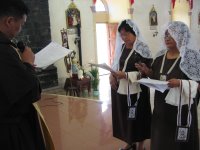OBEDIENCE AND PERFECTION
By Nimfa C. Tangcuangco, TOCarm
National Prioress
I was reading the novel “Memoirs of a Geisha” a few days ago [in anticipation, as I write this, of the movie that is probably showing in movie theaters around you by the time this publication comes out of the press) and somehow the book had its way of re-orienting me of the misconceptions I previously had about geishas as a whole. I even had to do some research in the internet to learn more about them. One particular site has this description of a geisha:
The word Geisha is derived from ‘Gei’, which in Japanese means performance or entertainer, and ‘sha’, which means person, and dates back 400 years ago to the ‘Edo’ period. During this time the Geisha entertained at banquets and social gatherings by playing a Japanese guitar (called a Shamisen), and singing and giving dance performances.
There is often a misconception by some that Geisha’s are prostitutes, but nothing could be further from the truth. Geisha are refined and cultured girls and women who are highly trained in a variety of traditional skills. Besides playing the Shamisen, singing and dancing, the Geisha perform the Japanese tea ceremony, and are well versed in the art of conversation. Many learn to speak English in order to entertain Western guests.
The training involved in becoming a Geisha is very rigorous, and because of this the numbers of Geisha are declining. Few young women in today’s society are willing to devote themselves to such demanding training. To become a Geisha, if accepted, a young girl must go through an apprenticeship that involves living with a head Geisha. This training period takes five to six years. During this time, the Geisha trainee must help with the chores and the running of the house, learn customs and social skills, and take music and dance lessons. After about six months, the trainee Geisha is called a maiko girl, and accompanies a Geisha on her appointments in order to become acquainted with customers. At about age 20, the maiko must make the decision to become a full-fledged Geisha or not. If a girl wishes to marry she cannot become a Geisha.
When we reflect upon it - a Lay Carmelite goes thru several stages as well for a minimum of six (6) years before he/she becomes a full-fledged Carmelite or a Final Professed member. During all these years we undergo formation studies to learn the history, culture, customs or ways on how to become Carmelites. Our objective is to go on a spiritual journey towards transformation in Carmel and be what we are supposed to be: active-contemplatives living a life of allegiance to Jesus Christ.
Oh well, you must be wondering what does being a Geisha have something to do with being a Lay Carmelite. In “Memoirs of a Geisha”, Sayuri (the lead character) had to undergo so much troubles and difficulties - she started training and attending Geisha School at age 9 (or was it 10?), became an apprentice Geisha at 15 and a full-fledged Geisha at 18 - before she could become the best and perfect Geisha that she was of her time. Mameha (her elder sister in the profession or her head Geisha) had once told her at the very start of her apprenticeship: “A geisha must be very careful about the image she presents to the world. Now as I say, I have very strict terms. To begin with, I expect you to do what I ask without questioning me or doubting me in any way. I know you’ve disobeyed Hatsumomo and Mrs. Nitta from time to time. You may think that’s understandable; but if you ask me, you should have been more obedient in the first place and perhaps none of these unfortunate things would ever have happened to you.”1
Teresa of Avila wrote that “The greatest perfection lies in obedience.” 2 Obedience is, without doubt, a most important ingredient in building up character and ensuring success in whatever a person aspires for in life. We hear of obedient students being great achievers and garnering honours for their schools and their parents. We see obedient children growing up to be responsible citizens and leaders of society, giving honour to God and country. In Lay Carmelite Communities obedient and compliant members contribute to the peace and orderliness in the Order and bring honour to Carmel.
Josemaria Escriva wrote, “Obedience is the humility of the will that subjects itself to the will of another, for God’s sake,”3 He further wrote, “Humility and obedience are the indispensable conditions for acquiring good doctrine.”4 In other words we are reminded that without humility we can never hope to practice perfect obedience. Disobedience is the product and result of pride, the sin of our first parents. Each time we disobey our pride invariably shows itself out.
In the Way of Perfection, St. Teresa of Avila wrote: “This attitude includes the great virtues of humility and mortification, careful obedience by not in any way going against what the superior commands, for you truly know that God, in whose place the superior stands, commands it. It is into this obedience that you must put the most effort; and, in my opinion, where there is no obedience there are no nuns…. I don’t know why a nun under obedience by vows is in the monastery if she doesn’t make every effort to practice this obedience with greater perfection. At least I can assure her that as long as she fails in obedience she will never attain to being a contemplative, nor will she even be a good active Sister….”5
In my six (6) years as National Prioress I have seen how disobedience to superiors in local communities has wrecked the peace and unity of a community; how it has stunted the spiritual growth and transformation of the members. Considering that we promise TO OBEY the rules of the Order during our profession, obedience then becomes a priority obligation in the life of a Carmelite. Considering also that the number one rule of St. Albert’s Rule refers to obedience to the Prior, obedience to our superior becomes a MUST DO for every member.
In “The Precautions”, St. John of the Cross teaches us that ‘obedience’ is the way to conquer the Devil. When writing about the second precaution against the devil, he declared:
“Let the second precaution be that you always look upon the superior as though upon God, no matter who he happens to be, for he takes God’s place. And note that the devil, humility’s enemy, is a great and crafty meddler in this area. Much profit and gain comes from considering the superior in this light, but serious loss and harm lies in not doing so. Watch, therefore, with singular care that you study neither his character, his mode of behaviour, his ability, or any of his other methods of procedure, for you will so harm yourself as to change your obedience from divine to human, being motivated only by the visible traits of the superior, and not by the invisible God whom you serve through him.
Your obedience is vain and all the more fruitless in the measure that you allow the superior’s unpleasant character to annoy you or his good and pleasing manners to make you happy. For I tell you that by inducing religious to consider these modes of conduct, the devil has ruined a vast number of them in their journey toward perfection. Their acts of obedience are worth little in God’s sight, since they allow these considerations to interfere with obedience.
If you do not strive, with respect to your personal feelings, to be unconcerned about whether this one or another be superior, you will by no means be a spiritual person, now will you keep your vows well.”6
The above precautions are addressed to those TOC members who are truly serious in their desire to reach perfection quickly. Without this genuine desire to reach perfection, these precautions will invariably fall on deaf ears. It is unfortunate that there are still a great number of our members and even local leaders who probably do not have a genuine desire to reach perfection, while in this earthly life, because they do not seem to strive or exert extra effort to learn the art of perfect obedience to God’s will through their duly instituted leaders of the Order.
(Footnotes)
1 Chapter 12, Memoirs of a Geisha by Arthur Golden, Published in the United States by Vintage Books
2 The Way of Perfection, Teresa of Avila, Chap 39, Item 3, page 190
3 J. Escriva, Furrow, n. 259
4 The Forge by Josemaria Escriva, n. 132
5 Way of Perfection by Teresa of Avila, Chap 18, Item 7 & 8, page 105
6 The Collected Works of St. John of the Cross, The Precautions, page 659








